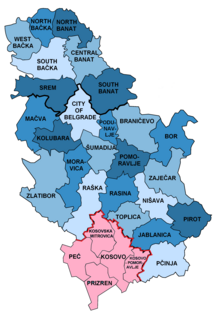|
Administrative districts of Serbia
The administrative districts (Serbian: управни окрузи, romanized: upravni okruzi) of Serbia are the country's first-level administrative division. The term okrug (pl. okruzi) means "circuit" and corresponds (in literal meaning) to bezirk in the German language. It can be translated as "county", though it is generally rendered by the government as "district". Prior to a 2006 decree, the administrative districts were named simply districts. The local government reforms of 1992, going into effect the following year, created 29 districts, with the City of Belgrade having similar status.[1] Following the 2008 Kosovo declaration of independence, the districts created by the UNMIK-Administration were adopted by Kosovo. The Serbian government does not recognize these districts. The administrative districts are generally named after historical and geographical regions, though some, such as the Pčinja District and the Nišava District, are named after local rivers. Their areas and populations vary, ranging from the relatively-small Podunavlje District to the much larger Zlatibor District. As they are mere designations of territorial remit of regional administrative centres through which the central government exercises its power within a hierarchical order, the districts are distinctly not units of regional self-governance, and as such they do not have flags. Still, they are each run by a commissioner as well as cooperating municipal leaders. Rather than being further divisible into municipalities, each district overlaps with its corresponding cluster of municipalities (which are units of local self-government). DefinitionAdministrative districts were first defined by the Government of Serbia's decree of 29 January 1992, which specifies that ministries and other national-level agencies shall conduct their affairs outside their headquarters (i.e. outside the seat of government) via regional offices that they may establish per the designated clusters of municipalities (named only "districts"), also designating the administrative seat of each district ("regional centre of state administration").[2] The 2005 Law on Public Administration provided a legal definition of a district, under the term "administrative district".[3]
In 2006, the Government enacted the Decree on Administrative Districts, which renamed the districts into administrative districts.[4] The territorial organisation of Serbia is regulated by the Law on Territorial Organisation, adopted by the National Assembly on 29 December 2007.[5] According to the Law, the territorial organisation of the republic comprises municipalities and cities, the City of Belgrade with special status, and autonomous provinces. Districts are not mentioned in this law. List of districtsUnder the Law on Public Administration, administrative districts are formed by the Government by its Decree on Administrative Districts, which also determines the territory and head office of each administrative district. There are 29 administrative districts in the Republic of Serbia.[6]
See alsoNotes and referencesNotes
References
Sources
External linksWikimedia Commons has media related to Districts of Serbia. |
||||||||||||||||||||||||||||||||||||||||||||||||||||||||||||||||||||||||||||||||||||||||||||||||||||||||||||||||||||||||||||||||||||||||||||||||||||||||||||||||||||||||||||||||||||||||||||||||||||||||||||||||||||||||||||||||||||||||||||||































